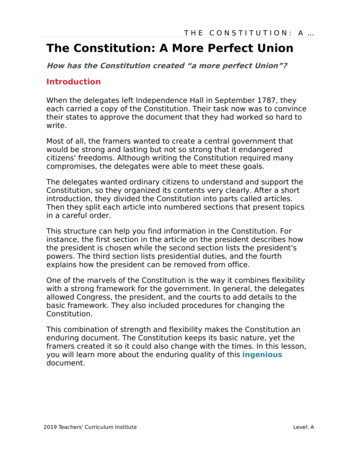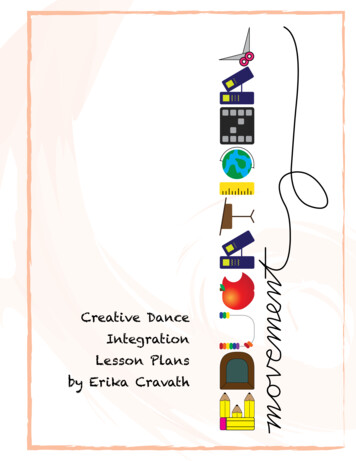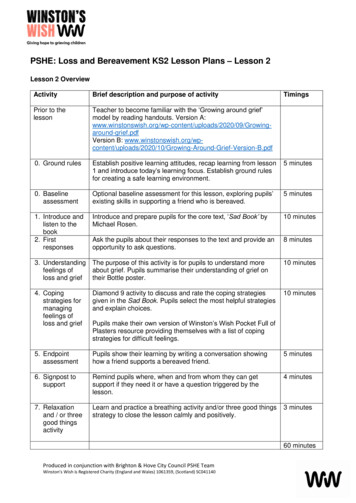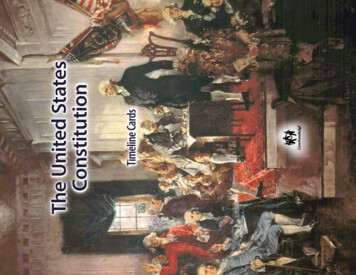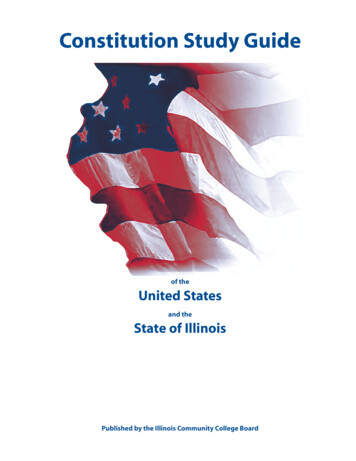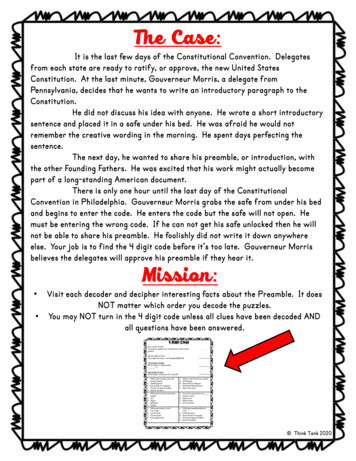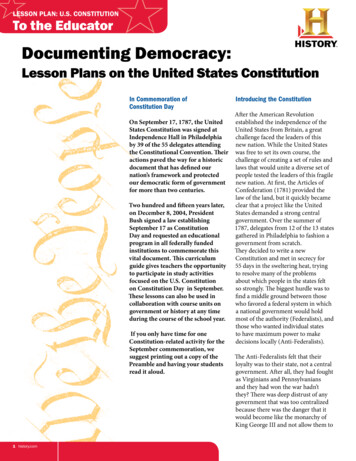
Transcription
LESSON PLAN: U.S. ConstitutionTo the EducatorDocumenting Democracy:Lesson Plans on the United States ConstitutionIn Commemoration ofConstitution DayOn September 17, 1787, the UnitedStates Constitution was signed atIndependence Hall in Philadelphiaby 39 of the 55 delegates attendingthe Constitutional Convention. Theiractions paved the way for a historicdocument that has defined ournation’s framework and protectedour democratic form of governmentfor more than two centuries.Two hundred and fifteen years later,on December 8, 2004, PresidentBush signed a law establishingSeptember 17 as ConstitutionDay and requested an educationalprogram in all federally fundedinstitutions to commemorate thisvital document. This curriculumguide gives teachers the opportunityto participate in study activitiesfocused on the U.S. Constitutionon Constitution Day in September.These lessons can also be used incollaboration with course units ongovernment or history at any timeduring the course of the school year.If you only have time for oneConstitution-related activity for theSeptember commemoration, wesuggest printing out a copy of thePreamble and having your studentsread it aloud.1 history.comIntroducing the ConstitutionAfter the American Revolutionestablished the independence of theUnited States from Britain, a greatchallenge faced the leaders of thisnew nation. While the United Stateswas free to set its own course, thechallenge of creating a set of rules andlaws that would unite a diverse set ofpeople tested the leaders of this fragilenew nation. At first, the Articles ofConfederation (1781) provided thelaw of the land, but it quickly becameclear that a project like the UnitedStates demanded a strong centralgovernment. Over the summer of1787, delegates from 12 of the 13 statesgathered in Philadelphia to fashion agovernment from scratch.They decided to write a newConstitution and met in secrecy for55 days in the sweltering heat, tryingto resolve many of the problemsabout which people in the states feltso strongly. The biggest hurdle was tofind a middle ground between thosewho favored a federal system in whicha national government would holdmost of the authority (Federalists), andthose who wanted individual statesto have maximum power to makedecisions locally (Anti-Federalists).The Anti-Federalists felt that theirloyalty was to their state, not a centralgovernment. After all, they had foughtas Virginians and Pennsylvaniansand they had won the war hadn’tthey? There was deep distrust of anygovernment that was too centralizedbecause there was the danger that itwould become like the monarchy ofKing George III and not allow them to
LESSON PLAN: U.S. ConstitutionTo the Educatormake decisions about their own lives.However, Americans also realizedthat a strong central government wasneeded to negotiate with large foreignpowers such as Spain and France, andto develop treaties and relations withNative Americans.There were other challenges tosolve. Small states wanted as muchrepresentation as the large statesbecause they were each distinctpolitical bodies, while the large statesthought they should have morerepresentatives because they hadmore people. The task at hand forthe delegates was to find a system ofgovernment that would be acceptableto all groups.Two key words are helpful inunderstanding how the United Statesarrived at a Constitution: balanceand compromise. The delegatesat the Constitutional Conventiondecided to establish one federalgovernment with three mainbranches: legislative, executive, andjudicial (the Congress, the Presidency,and the Supreme Court). Thepower of individual states would bepreserved by Congress, which wassplit between the Senate and theHouse of Representatives. Each statewould be allowed two senators andrepresentatives to the House based onthe size of the state’s population. Thislater became known as the “GreatCompromise.” Other compromisesincluded the decision to countAfrican Americans as three-fifths ofa person and to agree not to makeany laws barring slave importation2 history.comfor twenty years. Meanwhile, theNorthwest Ordinance of 1787 barredslavery from this new territory.Once the Constitution was written, itneeded to be ratified by the peopleof at least nine of the thirteen statesin order to be valid. Frenzied debateensued over the course of nearlya year – in newspapers, politicalmeetings, on street corners – beforethe Constitution was finally ratified byenough states in 1788. Worries aboutthe protection of individual freedomswere answered by the Bill of Rights, aset of ten Constitutional amendmentspassed in 1791. These additions to theConstitution promised that the federalgovernment would protect the rightsof individual citizens. The foundingdocuments had been determined, buta new process had been set in motionas Americans struggled to definethe boundaries of these words. Thisdocument, setting forth the rules fora representational democracy thatwas the first of its kind, is the oldestconstitution still in use today.ConstitutionalComponents:How is the ConstitutionStructured?The Constitution hasthree major components: e PreambleTh(We the People)The Articles (I-VII) The Bill of Rights(Amendments 1-10)Jump Starter: Print and distributethe full text of the Constitution atthe National Archives site atwww.ourdocuments.gov. Studentswill also enjoy looking at the originalversion of the Constitution, photos ofwhich are available at the same site.The Preamble to the Constitutionstarts with the phrase, “We thePeople of the United States,” ratherthan saying, “We the States.” Whatmight this difference mean?Fun Facts:Where in the world is the Constitution?The original draft of the Constitution is ondisplay at the National Archives in Washington, DC.Where was the Constitution sent for safe storage during World War II?Fort Knox.
LESSON PLAN: U.S. ConstitutionElementary SchoolDocumenting Democracy: The United States ConstitutionElementary School Lesson PlanIntroducing the Constitutionto younger students presents avaluable opportunity to build notonly knowledge of the foundingdocuments but also their senseof civic understanding andappreciation. A basic explanation ofthe American Revolution is a goodplace to start before leading studentsthrough the framework of theConstitution and how it is relevantto their everyday lives. Followingfrom this background instruction,you can bring the topic to lifethrough engaging activities they canpursue both in the classroom and intheir local communities.Goal:To gain a basic understanding ofhow the Constitution was created,how it is structured, and how itapplies to students’ present-daylives.Curriculum Links:This lesson plan would be usefulfor history, social studies, and civicscourses, and will complement courseunits on American government.Introduction to Educator:Provide students with a briefbackground on the Constitution* if yourclass has not already studied it (or needsa refresher), or simply use the lessonplan ideas below as a supplement toyour course units on the Constitution.Lead your class through the thoughtprocess behind the purpose of writinga constitution. Depending upon yourstudents’ reading level, the followingparagraph may be read aloud by astudent in class.A constitution is an agreed-upon setof rules and laws that tells peoplehow their government is set up, whattheir government can do, and whattheir government can’t do. In theUnited States today, every state hasa constitution. Some organizationshave constitutions. The most famousconstitution in America is the U.S.Constitution. It is the most importantone, too, for all Americans.In 1787, when our Constitution waswritten, very few countries had aconstitution. Rules and laws couldbe created and changed by the kingor other leaders. Great Britain had aconstitution, but it was made up of alot of different documents containingdifferent rules. In the United States,leaders now known as the “FoundingFathers” believed that it was necessaryto write down in one document the mostimportant rules for governing the newnation. These rules were so importantthat the Founding Fathers madesure they couldn’t be changed easily.Today, many countries have a writtenconstitution.Discussion Questions for YourStudents:1. What is a constitution?2. Who were the Founding Fathers?3. Why do you think the FoundingFathers believed that rules aboutgovernment should be written down?4. Do you agree or disagree? Why orwhy not?National Standards:This lesson plan is linked to statehistory standards in all 50 states andthe District of Columbia and is mostrelevant to the following thematicstrands of the National Councilfor the Social Studies curriculumstandards:II Time, Continuity, and ChangeV Individuals, Groups, andInstitutionsVI Power, Authority, andGovernanceX Civic Ideals and Practices3 history.com* Read introduction section on the US Constitution lesson plans in this manual for a brief background or consult Maestro,Betsy and Giulio Maestro, A More Perfect Union: The Story of Our Constitution (William & Morrow, 1991).We also recommend Joy Hakim’s A History of US , Volume 3, From Colonies to Country (Oxford University Press, 2003).
LESSON PLAN: U.S. ConstitutionElementary SchoolActivity #1: Power Words — The Constitution QuestSupplies needed: Note cards, pens/pencils and paper, smallcontainers, bags, or ribbon to hold clues for the quest(plastic eggs from an egg-hunt would be a good option orrolled-up paper tied with colorful ribbon).Start this activity by defining the terms below (or ageappropriate terms pertaining to the Constitution) with thelarger class or group. Provide each student with writtendefinitions after the discussion and have them study theterms so they are familiar with the definitions. Break upthe students into groups of four. In an open school oroutdoor space, hide the terms below, without definitions,in containers or tied with ribbon. Tell students ahead oftime how many clues have been hidden. Send students ona scavenger hunt to find the terms, and reconvene with thelarger group when they have all been discovered.Have the students define the terms from memory in theirgroups and present them out loud. Tally up the numbers ofcorrect definitions. Present the group with the most correctanswers with a small prize or treat.ConstitutionBill of RightsPresidentTaxationConstitutional ConventionSeparation of PowersU.S. CongressFounding FathersDelegateSupreme CourtCitizenFederal GovernmentSenatorChecks and BalancesArticles of ConfederationAmendmentRepresentativeDid You Know?Did you know that Thomas Jefferson andJohn Adams did NOT sign the Constitution?4 history.com
LESSON PLAN: U.S. ConstitutionElementary SchoolActivity #2: The Roles and Responsibilities of GovernmentOne of the most important aspects of the U.S. Constitutionis that it established the role of the federal government,breaking down its responsibilities into three distinctbranches. Provide students with the helpful chart below andlead a discussion of the three branches of government andthe roles of each. Create three columns on the blackboard orcomputer with each of the three branches, and list the rightsand responsibilities of each one.Discussion Questions:1. Based on the chart below what are the three branches ofgovernment established by the Constitution? Why doyou think the authors of the Constitution created thesebranches? Why doesn’t the President just run everything?2. D o you think our country needs a constitution?What if the United States had no rules at all?What would happen if the rules changed frequently?3. Discuss how the Constitution set up centralized rules,called the federal government, so that some rules will bethe same from state to state. For example, as you travelfrom one state to another, the currency is the same,there are post offices that carry letters and packagesacross states, and there are armed forces that representthe entire nation. Why is this important? What wouldthe Unites States be like, for example, if each state hadits own form of currency?4. B onus questions: If you were going to work for one ofthese three branches of government, which would it be?(Citation: This graphic is borrowed from the excellent and informative Ben’sGuide to U.S. Government for Kids, available at http://bensguide.gpo.gov)Post-Discussion Activity:Break students up into groups of four or five, and thendistribute the following challenge to each group. Havethem present their answers at the end of class. After all ofthe presentations have been delivered, ask the students todiscuss highlights from each presentation.Quick! The country has just passed a new law: every school must form its own constitutionand submit it to the state government by the end of the week.Luckily, your group has some knowledge, so your principal has called upon you to help with this task.Working together with your group, write up ten rules that will be included in your school constitution.Be sure to remember the most important thing the framers of the U.S. Constitution realizedduring the Constitution Convention:5 history.comit’s important to compromise!
LESSON PLAN: U.S. ConstitutionElementary SchoolActivity #3: Three C’s: Constitution, Cooperation,Compromise (A Life Skill Lesson)Teaching the Constitution presents many opportunities forlife skill lessons for elementary students, such as explainingthe value and meaning of “compromise.” Explain to studentsthat the Constitution was the product of great debate in whichall states had to give up some of what they wanted for thesake of the whole – the common good. There were two majorplans presented by the delegates, though together they finallyagreed on a third.Discussion Questions:1. In 1787, Virginia was one of the biggest stateswith many residents. Why do you think it wantedrepresentation to be basedon population size?2. If you had been a delegate at the ConstitutionalConvention, which planwould you have chosen?Why?Virginia Plan:This plan was favored by bigger states. It focused on buildingone strong federal government. Representation was based onthe size of a state’s population.3. What are some situations in your own life in whichyou have had to compromise? What was the benefitfor you? For others?New Jersey Plan:This plan gave each state equal representation regardless ofpopulation.4. Bonus questions:Which Founding Fatherproposed the “GreatCompromise”? Where didhe live? What is hisstate’s motto?The Connecticut Plan:Known later as the “Great Compromise” this plan establishedthe Senate, in which each state would have two senators, and theHouse, where representation would be based on population.Activity #4: “We the People” Art ProjectIntroduce students to the Preamble to the Constitution.Distribute a copy of the Preamble or write it on the boardand lead a discussion of the phrase “We the people ofthe United States,” and a basic definition of democracy.Explain that in 1787, when the Constitution was written,primarily white men were included in the idea of “We thepeople.” Today, that notion has changed to include womenand people of all races and ethnicities. Following thisdiscussion, ask students to create a painting or drawingwhich represents their vision of who “We the people ofthe United States” are, and what the phrase means to them.You can also have students write poems to explore thistopic, with the guideline that their poems must start withthe words, “We the People.” Have students explain theircreations to the larger class or group and display them onyour class bulletin boards or in the hallway.6 history.com
LESSON PLAN: U.S. ConstitutionElementary SchoolActivity #5: Oral History Project(Local history application)In class, explain to students the roles and responsibilities ofthe President. Then, ask them to interview an older familymember, friend, or member of their community about thePresidents they remember or admire. Ask this person thefollowing questions, and write down the answers to sharewith the larger class in short presentations.1. W hich President do you thinkhasimportant in U.S. history? Why been most?2. During which era of American history didPresident live?thisWhat were themost importanissues this Presitdent faced?3. W hat are the three qualities you think are mosimportant for Ptresidents to have? What aretheir most important roles andresponsibilities?Activity #6: The Constitution at Work(Local history application)Find a lawyer, public advocate, or other civic official in yourcommunity who uses the Constitution in some way fortheir job. Invite them to come to your school to discussFun Fact:with students how the Constitution relates to the job theyperform, and to everyday life.Benjamin Franklin was the oldest member of theConstitutional Convention at the age of 81.Jonathan Dayton of New Jersey was the youngestat a mere 26 years old.7 history.com
LESSON PLAN: U.S. ConstitutionMiddle SchoolDocumenting Democracy: The United States ConstitutionMiddle School Lesson PlanMiddle school students in manystates are expected to understand thestructure of the U.S. Constitutionand the process of ratification.Encouraging them to see theConstitution as a document relevantto their own lives is an excellentway to keep them interested asthey develop their vocabulary andsophistication in understandingthe more advanced concepts theConstitution introduces. Thefollowing activities are offered assuggestions for enlivening courseunits on the discussion and inspiringyoung people to not only see therelevance of the founding documents,but to want to learn more!Goal:To build an understanding of theConstitution, how it is structured,and how it can be applied practically.Curriculum Links:This lesson plan would be usefulfor history, social studies, and civicscourses, and will complement courseunits on American government.National Standards:This lesson plan is linked to statehistory standards in all 50 states andthe District of Columbia and is mostrelevant to the following thematicstrands of the National Councilfor the Social Studies curriculumstandards:II Time, Continuity, and ChangeV Individuals, Groups, andInstitutionsVI Power, Authority, andGovernanceX Civic Ideals, and Practices8 history.comIntroduction to Educator:The lesson plan suggestions beloware geared toward students whohave some knowledge of theConstitution and its role in U.S.history. These activities can be usedas an introduction to course unitson the Constitution or can be usedto supplement lesson plans you havealready created. By completing thefirst three activities, students willgain insights into the three maincomponents of the Constitution:the Preamble, the Articles, and theBill of Rights. Students requiringadditional background informationcan consult the Resources section atthe conclusion of these lesson plans.Activity #1:The Building Blocks for GovernmentThe Preamble to the Constitution isperhaps one of the most often heardand quoted passages in Americanhistory. Studying the Constitutionallows students to reflect on whatthe passage actually means and whatit indicates about the document tofollow. For this activity, distribute acopy of the Preamble to students. Aninteresting note to start with is thedefinition of “preamble.” Translatedfrom Latin, the term means “to walkbefore.” Lead a class discussion askingstudents what the following termsmean and why they are relevant tothe Constitution:perfect unionjusticeinsure domestic tranquilitycommon defensegeneral welfaresecure the blessings of libertyThen, break students up into groups.Tell them that their task is to rewritethe Preamble, being sure to keeptheir new Preamble to one sentenceor less. Ask them to share their newPreamble with the larger class orgroup, and have the class vote on thebest Preamble.
LESSON PLAN: U.S. ConstitutionMiddle SchoolActivity #2: Artistic Articles!Students should understand that the Constitution includesseven articles that established different aspects of thegovernment and the ratification of the Constitution itself.Break the class or group into seven smaller groups andask each group to research and interpret one of the sevenarticles. Then, their task is to help the rest of the class buildtheir knowledge through a creative performance describingthe main contributions of their article. These can bepoems, songs, cartoons, or PowerPoint presentations, butthe focus should be on giving the rest of the class a clearunderstanding of their article in a creative and entertainingway. Students should also provide a written explanationof the article to be read aloud. After a brief review, quizstudents on the seven articles. (An alternative to thisactivity would be to have students create bulleted lists ofthe key elements of each article and then choose one articleto focus on in creative presentations.)Activity #3: Do You Know Your Rights?The Bill of Rights can be one of the most exciting aspectsof studying the Constitution for young people becausethe concept of “rights” and rules are so applicable to theireveryday lives. Drawing from current events and debatesin the news is an ideal way of showing students the validity,and even urgency, of studying the Constitution. Remindstudents through an introductory lecture or refresher thatone of the biggest objections to ratifying the Constitutionfrom some delegates was that it did not include a Billof Rights. The Bill of Rights was passed as the first tenAmendments to the Constitution in 1791.For this activity, distribute a copy of the Bill of Rights tostudents and lead them through these first ten ConstitutionalAmendments. Then, have students conduct individual researchon the Bill of Rights and create a PowerPoint presentationor scrapbook with two slides or pages devoted to eachAmendment. The first should have a brief synopsis of theAmendment and the second should be a modern-day orhistorical application of the Amendment. Encourage studentsto scan or search for newspaper articles on the Internet orat home that relate to a Constitutional Amendment orBill of Rights related issue. Have students share the mostinteresting current or historical case drawn from one of theAmendments with the larger class or group.Activity #4: Oral History Project(Local history application)Have students interview an older family member orcommunity member about the Supreme Court. Havestudents ask this person which Supreme Court case, eitherwithin their lifetime or throughout U.S. history, is the onethey think is the most important or memorable. Then, havestudents explore the case and find additional backgroundon the era and political context in which it took place.“Ask each student to share the following information in apresentation of 3 minutes: who they interviewed, the courtcase they examined, the historical context in which it tookplace, and the Constitutional issue at stake. Make a list of allof the cases and have students vote on which case they thinkis most important after hearing these reports.”Keeping the past alive helps our young people understandwhere we come from and how we must move forward.- Speaker of the House Dennis HastertSpeaker Hastert received a Save Our History Leadership awardfrom The History Channel in May 2005.9 history.com
LESSON PLAN: U.S. ConstitutionMiddle SchoolActivity #5: Save the Constitution!Another crucial concept that the Constitution can helpus teach is the value of compromise. After explaining theHelp! The Constitution is inseveral hot summer months an“Great Compromise” to students, distribute the followingchallenge to students.trouble. The Constitutional Conventionsmaller states continue asd still no final document has been produced. Conflictsboth sides feel their interests will be sacrificed by theYour help is greatly neededand he has decided to votagreement. While everyoneyou have actually been fole against the “Great Compinhas gone on forbetween the larger andConstitutional plans on the: your father or brother is a delegate from Deromise” which would leaveyour family thinks you are shytable.laware,the Constitution just shortof anand oblivious to the debate,lowing ver y closely and have some of the best insights into why the “Great Compis the best path for the Coromise”nvention to follow. Write animpassioned letter to yourfather or brother makingthe argument for why theis the best plan and why anagreement on theConstitutional draft is necessar y.“Great Compromise”Activity #6: Bringing the Constitution to the Community(Local history application)After gathering this knowledge of the Constitution, askstudents to share what they have learned with the youngerstudents at their school. Assign each student an identity,either as a founding father, Constitutional delegate, anArticle of the Constitution, a Supreme Court Justice, or oneof the ten amendments in the Bill of Rights.Then, have students dress in clothing or create a t-shirtrelevant to their identity. Organize for the students toperform for younger students at the school (or for oldermembers of a community center, hospital, or adult livingenvironment). Each student should describe their identityand one fun fact related to the Constitution.Did you know?Did you know that of the 55 delegatesto the Constitutional Convention,24 were lawyers or had studied law?10 history.com
LESSON PLAN: U.S. ConstitutionHigh SchoolDocumenting Democracy: The United States ConstitutionHigh School Lesson PlanAt the high school level, manystudents will be familiar with thestructure of the Constitution and theprocess of ratification. Studying theConstitution presents many excellentopportunities for students to pursuerigorous debate, build criticalthinking skills, and get studentsexcited about civic participationas they approach voting age. Theseactivities should help provide aninformative and entertaining way forstudents to accumulate knowledgeof the Constitution while findingtheir own answers to the commonquestion, “Why should I care?”Goal:To build an advancing knowledgebase of how the Constitution wascreated, how it was structured, andhow it applies to student’s presentday lives.Curriculum Links:This lesson plan would be usefulfor history, social studies, and civicscourses, and will complement courseunits on American government.National Standards:This lesson plan is linked to statehistory standards in all 50 statesand the District of Columbia andis most relevant to the followingthematic strands of the NationalCouncil for the Social Studiescurriculum standards:II Time, Continuity, and ChangeV Individuals, Groups, andInstitutionsVI Power, Authority, andGovernanceX Civic Ideals and Practices11 history.comIntroduction to Educator:Many states have implementedassessment tests on the Constitutionand structure of government, inaddition to the course expectationsthat schools have for their highschool history and civics students.These lesson plans are not intendedas preparation for these tests,but rather to supplement courseunits and provide fresh ideas forhow to invigorate the study of theConstitution in your classroom.Activity #1:Charting Constitutional HistoryFor this two-part activity, studentswill create a Constitutional“storyboard” as a way of organizingand reviewing their knowledge of theConstitution. One of the best waysto study and review the complexityof the Constitution is for studentsto create a visual representation ofthe chronology of events and theirhistorical relevance. Constructing aConstitutional “storyboard” is oneway for students to trace the narrativeof the Constitution and ratificationprocess. Explain to students thatfilmmakers and writers often use“storyboards” when they are writingfilm scripts. These can be eithercharts or drawings that representthe chronological structure of astory. Students may want to researchstoryboards online or using theInternet in order to get a sense of thevariety of how they can be constructed.Then, have students construct theirown storyboards. These can be textbased or include drawings but theymust include the following events andterms (including those you or yourstudents want to add) and explaintheir Constitutional relevance:Declaration ofIndependenceDelegates“Connecticut Compromise”Separation of PowersAnti-FederalistsArticles of ConfederationNew Jersey PlanThree Branches ofGovernment (list and define)“Three-fifths” ClauseRatificationConstitutional ConventionVirginia PlanSovereigntyFederalistsBill of Rights (List all 10)
LESSON PLAN: U.S. ConstitutionHigh SchoolActivity #2: From Storyboard to Story BookA great way to assess whether students have absorbedinformation about the Constitution is to test their abilityto explain what they have learned to others. Have studentsuse the storyboards they created for Activity #1 to writeand illustrate a Constitutional story designed for 5thgraders. These stories can be a series of drawings, writtenin text form, or presented as cartoons. The goal of thesestories is to challenge high school students to translatetheir knowledge of the Constitution in a new way. Theyshould imagine that they will be reading these books, sothey can frame their stories in their own language as longas they include relevant information about the Constitutionand the process of ratification. Have students share thesepresentations with younger students at your school or inyour community. Or, have the class invite younger studentsto your classroom for a Constitution story time.Activity #3: A Conversation from History:Federalism vs. Anti-FederalismThe debate between the Federalists and Anti-Federalists wasone of the most fiercely contested arguments during theratification process. By understanding this debate, studentswill gain invaluable insights into debates about the structureof government that continue today. For this assignment, havestudents research the Federalist/Anti-Federalist split, askingthem to locate the arguments made by James Madison,Patrick Henry, John Jay, or other leading intellectuals of theera. Then, ask them to pretend that they are on a c
* ead introduction section on the US Constitution lesson plans in this manual for a brief background or consult Maestro, R Betsy and Giulio Maestro, A More Perfect Union: The Story of Our Constitution (William & Morrow, 1991). We also recommend Joy Hakim’s A History of US , Volume 3,

